Keywords
|
| color segmentation, edge enhancement, blob measurements, Hough transform. |
INTRODUCTION
|
| Banks uses bill counting machine to enumerate the money. But when the customer wants to pay a large number of cash into the bank, bank staffs maymake mistakes to calculate the total value and number of one rupee, two rupee, five rupee, and ten rupee coins used. Some coins from different foreign currency look similar. So sometimes it is difficult to distinguish them by using human eyes, especially for large amount of coins. |
| Moreover, because of the globalization, the banks often receive foreign currency that the staff may not recognize. The charities face the same situation as the bank, because the donators come from all over the world. So it is necessary to develop a system that can help them to recognize and calculate the money that they receive. |
| • Problem statement |
| Most of the conventional identification methods used in slot machines, work by testing physical properties of coins such as size, weight and materials. However, if physical similarities exist between coins of different currencies, then the traditional coin testers would fail to distinguish the different coins. |
| • Objective |
| The main purpose of this project is to apply computer vision techniques to develop a program which should recognize coins in an image, and enumerate their value. That is to have a computer read the image and calculated the total value of the coins which are on the image. There are several techniques involved, such as image color segmentation, image edge detection, noise filtering, and Hough transformation and so on. |
LITERATURE SURVEY
|
| There are various approaches proposed by various researchers for image based coin recognition. Most of the approaches proposed till now can be applied for recognition of modern coins. |
| In 1992 Minoru Fukumi et al. presented a rotational invariant neural pattern recognition system for coin recognition [1]. In this work they have created a multilayered neural network and preprocessor consists of many slabs of neurons. This preprocessor was used to get a rotational invariant input for the multilayered neural network. For the weights of neurons in preprocessor, concept of circular array was used instead of square array. |
| In 1993 Minoru Fukumi et al. tried to achieve 100% accuracy for coins[2].In this work they have used Back propagation and genetic algorithm to design neural network for coin recognition. back propagation is used to train the network. |
| Paul Davidsson in 1996 presented an approach for coin classification using learning characteristic decision trees by controlling the degree of generalization [3]. Decision trees constructed by ID3 like algorithms were unable to detect instances of categories not present in the set of training examples. Instead of being rejected, such instances get assigned to one of the classes actually present in the training set. hieve 100% recognition accuracy rate. Michal Nolle et al. At the ARC Seibersdorf research centre in 2003 developed a coin recognition and sorting system called Dagobert[4]. This system was designed for fast classification of large number of modern coins from 30 different countries. |
| In 2004 Seth McNeill et al. presented a coin recognition system to recognize US coins using vector quantization and histogram modeling[5]. The system mainly focuses on the texture of various images imprinted on the coin tail. based on the different image texture the system differentiate between Bald eagle on the quarter, the Torch of liberty on the dime, Thomas Jefferson’s house on the nickel and the Lincoln memorial on the penny. Experiment show that out of 200 coins images 188 were correctly classified. thus 94% recognition accuracy rate was achieved. |
PROPOSED METHOD
|
| The proposed method of coin recognition consists of image acquisition, segmentation,edge enhancement, edge detection,blob measurements and finally count the total value of the coins. |
| The most appropriate computation strategy used in this paper should be graph matching. According to this strategy, the coins should be classified into different groups by their features. The features used in this paper could be the colors and the radiuses |
| This paper presents morphological operation for coin detection and enumeration of total value of the coins. The program working conditions should be set up to improve the efficiency and effectiveness of the program. Because there are hundreds conditions about how the coins display on an image. For instance, the size and shape of the same coin could also vary according to the position of the camera that captures the coins. If the camera is placed just above the coin, the shape of the coin will be a circle. Otherwise, the shape of the coin will be ellipse. And also if the camera placed near the coins, the size of the coin on the image captured by the camera will be relatively bigger than the size of coins captured by the camera which placed far from the coins. Although these two problems can be solved by using scale, the time of this project is restricted |
| Following diagram shows the flowchart of methodology |
| A. Condition: |
| • Lighting condition |
| • Distance and Position |
| • Perpendicular image acquisition |
| • Take care of the surface is clean |
| • Position of the camera is fixed |
| B. Proposed Algorithm: |
| Step 1: read input image |
| Step 2: convert input image into gray scale image |
| Step 3: image segmentation |
| Step 4: edge enhancement of segmented image. |
| Step 5: edge detection after enhancement |
| Step 6: labeling the objects |
| Step 7: blob measurements of labeled objects |
| Step 8: result the value of the coins |
| Step 1:Read Input Image and ColorSegmentation |
| In this stage, good camera is used to capture images of coins.The coins on the input image should be classified into groups according to their colours. The output image should be the coins belonging to the same colour group on the input image. This stage was divided into four substeps. |
| • Select the colour region. |
| • Calculate the “average” colour of the selected region, which is called mean. |
| • Find the measure of similarity between each colour pixels in selected region and the mean, which is called threshold. |
| • Segment the coins on the input image with the same colour as the selected region by using the mean and threshold found. |
| Step 2: Edge enhancement |
| After segmentation in step 1, the image containing the coins that were in the same colour group would be exported as a binary image. However, the pixels of the coins on this output image were not connected because not all the pixels of the coin could be found in step 1. In order to improve the accuracy of Hough Transform, the clear edges of the coins were required. In other words, edge enhancement was required. The substeps were shown below: |
| • Reduce the noisy. The isolate pixels on the image should be removed in this stage. |
| • Fill the region. Fill the gaps within the coin in order to recover the pixels that is lost in stage one. Now the edge of the coin should be clear. |
| Step 3: Edge detection |
| In step 2, the image containing the coins with cleared edges was outputted. The next step is detecting the edges of the coins,after applying Morphology algorithm to enhance the edge, could see that the edge of the coins was clearly shown on the image. Now use the edge detector to find the edge of the coins. The Canny edge detector was chosen in this paper then output them. There was no sub steps needed |
| Step.4: Blob measurements (Hough Transform for the circles) |
| After using canny edge detector, the edges of the coins should be exported. Now use Hough Transform algorithm to analyze these edge pixels, so the Hough Transform algorithm was used to detect the circles (the shapes of the coins). Once the centers and the radiuses of the circles were found, the value of the coins in the same group could be calculated. |
RESULTS AND SNAPSHOTS
|
| The proposed method is implemented using MATLAB 2013. Results are analysed. Following snapshots shows the results after MATLAB simulation |
| Above snapshot illustrate the program GUI to select image, which includes input image, test image, coin matching, result of testing, identification, finally value of the coins. |
| Above snapshot illustrate the result of coin matching. First input image is selected and it is compared with selected image, finally output the result. |
| The above snapshot illustrates the result of coin matching and result of total value of the coins. Here first image is identified, then radius is calculated, finally output the result. Also display the number of ten rupee coins used. |
| The above snapshot illustrates the result of coin matching and result of total value of the coins. Here first image is identified, then radius of each coins is calculated, finally output the result. Also display the number of two rupee coins used. |
CONCLUSION AND FUTURE WORK
|
| Coin recognition using morphological operations shows positive signs for coin identification. Image segmentation used as the first step reduces total time requires executing the program. Edge enhancement provides the clear edges of the coins to improve accuracy for coin detection. Also blob measurements are provided to give precise results. |
| Future works will include modifications of the technique and also merging of other image processing techniques, such as, Neural Networks training using Edge detection which would extricate the process from the dependency over standard light intensity and standard distance between coin and camera during image acquisition adding on to the accuracy of the process. |
Tables at a glance
|
 |
| Table 1 |
|
Figures at a glance
|
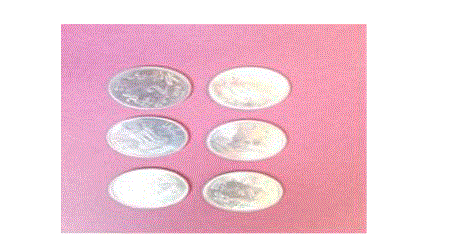 |
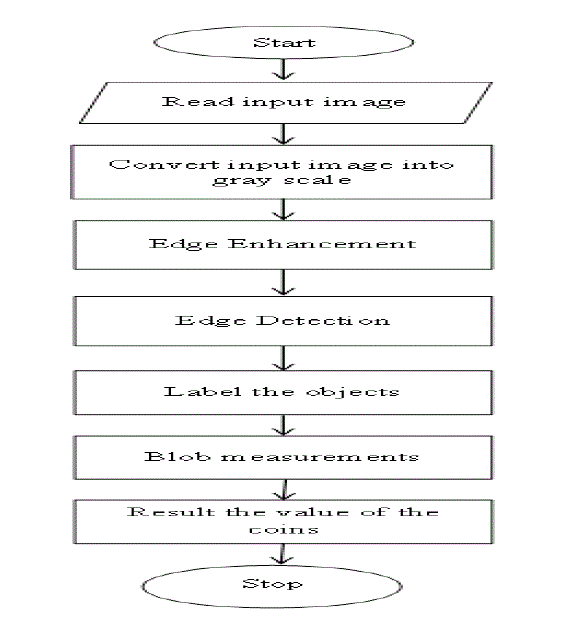 |
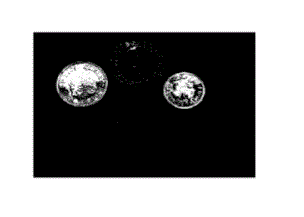 |
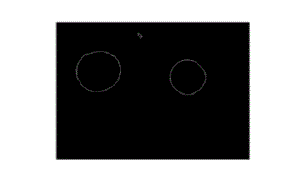 |
| Figure 1 |
Figure 2 |
Figure 3 |
Figure 4 |
|
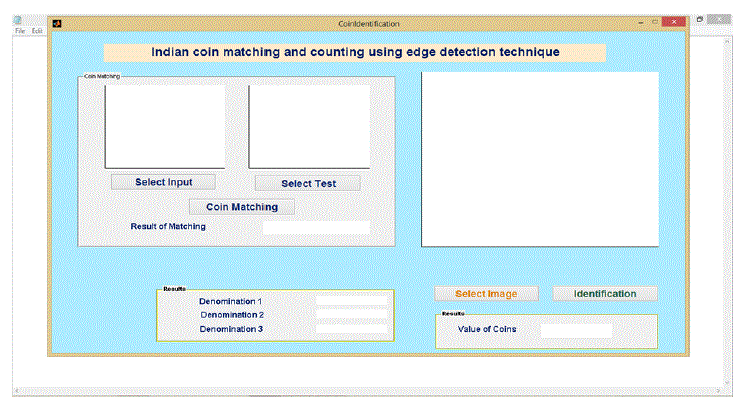 |
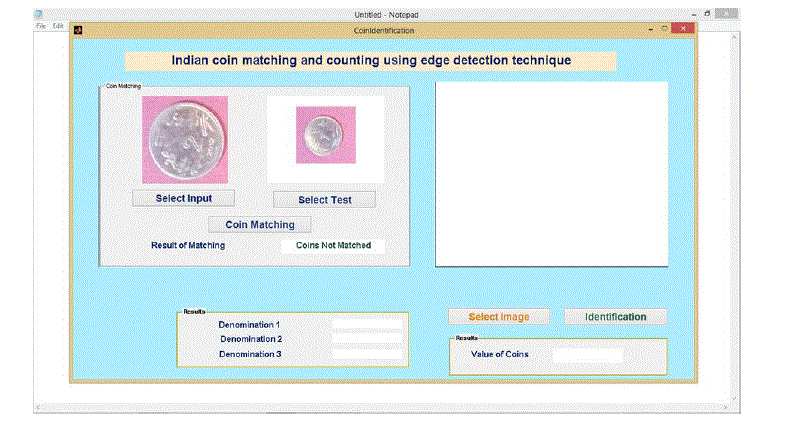 |
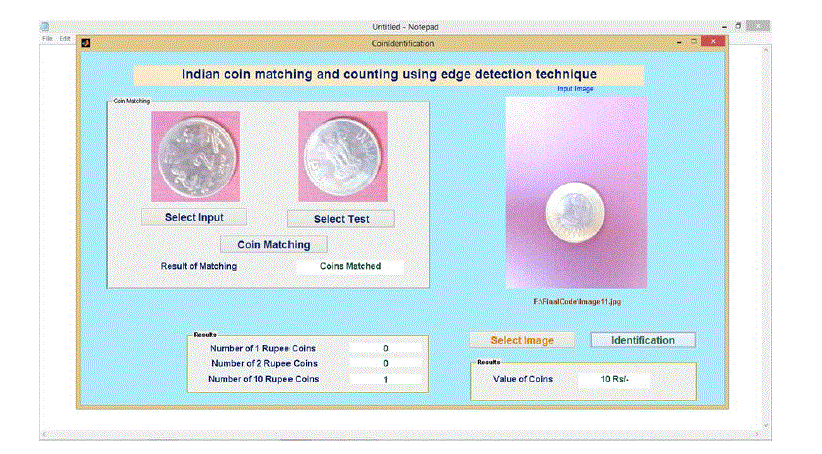 |
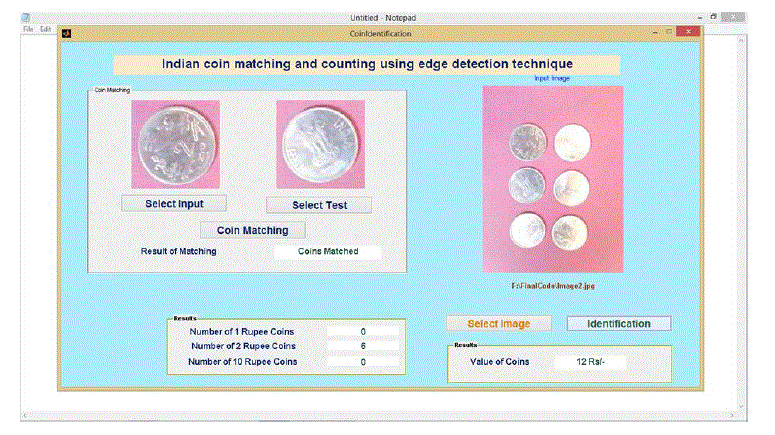 |
| Figure 5 |
Figure 6 |
Figure 7 |
Figure 8 |
|
References
|
- M. Fukumi, S. Omatu, "Rotation-Invariant Neural Patten Recognition System with Application to Coin Recognition", IEEE Trans. Neural Networks, Vol.3, No. 2, pp. 272-279, March, 1992
- Minoru Fukumi et al. “tried to achieve 100% accuracy for coins”.1993
- Paul Davidsson“an approach for coin classification using learning characteristic decision trees”.1996
- M. N¨olle, P. Harald, R. Michael, K. Mayer, I. Holl¨ander, and R.Granec, .Dagobert–“ a new coin recognition and sorting system,. in Proc. DICTA Digital image computing techniques and applications”, vol.1, pp. 329.338.2003.
- Seth McNeill et al. “a coin recognition system to recognize US coins using vector quantization and histogram modeling”, 2004.
- J. Provine, Mike McClintock, Kristen Murray, and Angela Chau, “Automatic coin counter”.
- D.Zhang and L. Guojun,.”Shape-based image retrieval using generic Fourier descriptor”, Signal Processing: Image Common., vol. 17, no. 10,pp.825.848,2002
- E. Ashbridge, D.I. Perrett, M.W. Oram and T. Jellema, “Effect of Image Orientation and Size on Object Recognition: Responses of Single Units in the Macaque Monkey Temporal Cortex”, Cognitive Neuropsychology Vol. 17: 1/2/3, pp. 13–34, 2000.
|